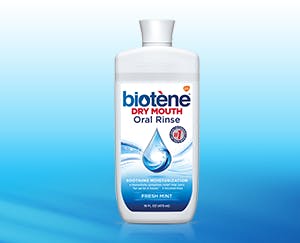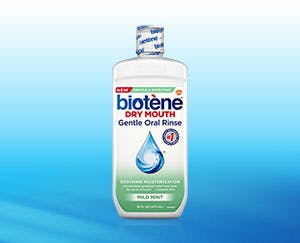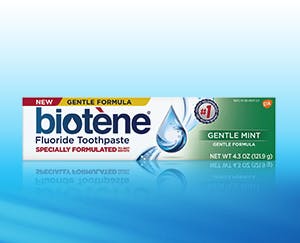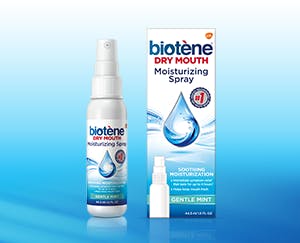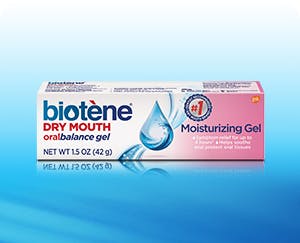If you have dry mouth, then you know how difficult it can be to enjoy the foods you love. Having less saliva in your mouth can affect how foods taste and make it harder to eat dry foods.1 Plus, some people with dry mouth become sensitive to certain foods or find it more difficult to swallow with a lack of saliva.1 Ordering food at a restaurant or enjoying a meal with friends can be tough when you’re not sure which foods can harm or help your dry mouth. Thankfully, you can find plenty of foods that help dry mouth at your favorite restaurant or grocery store. Use this guide from Biotène to learn about foods that can help your dry mouth symptoms.
Common Dry Mouth Causes and Symptoms
Dry mouth most often occurs as a side effect of medications, and people who take multiple medications are likely to be at a higher risk of experiencing oral dryness.2 More than 400 over-the-counter medications and prescription drugs are known to contribute to dry mouth.2 Besides medications, certain medical conditions and aging can contribute to dry mouth as well.2
Some common symptoms of dry mouth include:2
- A sticky, dry or burning feeling in the mouth
- Cracked or peeling lips
- Bad breath (halitosis)
- Altered taste/intolerance for foods and drinks that are spicy, salty or sour
- Difficulties with chewing, swallowing, tasting or speaking
- Dry/rough tongue
- Feelings of hoarseness
- A dry or sore throat
A decrease in saliva flow can eventually lead to oral problems like tooth decay and gum disease.1 Saliva helps to neutralize the acid that attacks your teeth when you consume sugary or acidic foods or drinks, and saliva helps fight the bacteria that forms dental plaque.1 Having dry mouth symptoms doesn’t always mean you have it, but it’s important to talk about your symptoms with a dental professional.1
Managing Dry Mouth Before Mealtimes
Whether you’re dining alone or with others, dry mouth shouldn’t prevent you from eating nutritious foods. If you are worried that your dry mouth might interfere with your meal, there are a few things you can try throughout the day to stimulate the flow of saliva and keep your mouth moist. You can sip on water throughout the day and let ice chips dissolve in your mouth.3 Drinking water is good for helping to relieve the dry, sticky feeling in your mouth, but it can only help in the short term.1 For dry mouth relief that lasts longer, try oral rinse products that are formulated for dry mouth like Biotène Dry Mouth Oral Rinse and Biotène Dry Mouth Gentle Oral Rinse. Biotène oral rinses are specially formulated to freshen breath and relieve dry mouth symptoms for up to four hours.
Before mealtimes, pop in a piece of sugarless chewing gum or sugarless hard candy to help your mouth produce more saliva.3 You can also try a Biotène Dry Mouth Lozenge, which is great for on-the-go dry mouth relief. Avoid doing things that could dry your mouth like smoking cigarettes.3 Dry mouth will make it difficult to swallow your foods, so make sure to keep your mouth moistened prior to eating.1
Foods to Try and Foods to Avoid with Dry Mouth
Knowing which foods are less likely to make your dry mouth will be helpful when it’s time to eat. See what types of foods you can try and what types to avoid when choosing meals.
Foods to Try
When eating with dry mouth, it’s important to focus on choosing foods that are easier to chew and swallow.4 Try cutting up your foods into smaller pieces to make them easier to eat.4 Some soft foods that may be easier to eat include:4
- Scrambled eggs
- Pudding
- Mashed potatoes
- Rice
- Canned fruits or apple sauce
- Soups and stews
- Protein-heavy foods like cheese, yogurt, beans and smoothies
If you want to eat sugary foods like popsicles and ice cream, make sure you are eating them during a mealtime and not in between meals.3,4 Citrus fruits are also great for stimulating saliva flow but can harm tooth enamel with their acidity, so try to neutralize the acid with milk or other dairy-rich foods.4,5 Drink plenty of water throughout the meal to keep your mouth moist and make it easier to swallow your food.4
Foods to Avoid
To minimize the risk of eating difficulties, here are some types of foods to avoid when you have dry mouth:3
- Beverages with alcohol or caffeine
- Foods that are spicy or salty
- Carbonated beverages like sodas
- Dry foods like bread and crackers4
- Hard foods that are difficult to chew4
Managing Dry Mouth After Meals
Avoid sugary snacks and beverages after you finish eating to reduce the risk of dental caries.3 Aim for sugarless snacks that contain sweetening agents like xylitol to keep your mouth busy and moisturized.3 You can soothe your dry mouth symptoms and freshen your breath with products like Biotène Moisturizing Oral Spray.
Eating with dry mouth can be a challenge, but it shouldn’t stop you from enjoying a nice meal. Learn about the best picnic foods to eat with dry mouth and explore more helpful resources on living with dry mouth.
Source Citations:
- Dry Mouth. Oral Health Foundation. https://www.dentalhealth.org/dry-mouth Accessed 3/18/2022.
- Xerostomia. American Dental Association. https://www.ada.org/resources/research/science-and-research-institute/oral-health-topics/xerostomia Accessed 3/18/2022.
- Management of Dry Mouth. Johns Hopkins Medical Center. https://www.hopkinssjogrens.org/disease-information/treatment/management-of-dry-mouth Accessed 3/18/2022.
- Nutrition Tips for Managing Dry Mouth. Pearlpoint Nutrition Services. https://pearlpoint.org/nutrition-management-of-dry-mouth/ Accessed 3/18/2022.
- Erosion: What You Eat and Drink Can Impact Teeth. American Dental Association. https://www.mouthhealthy.org/en/az-topics/e/dietary-acids-and-your-teeth Accessed 3/18/2022.



